Walking the dog with my smartphone led me to compile a series of photos of faces in trees over four years from 2016. These regular walks were the refresh I needed from my PhD research into property development pressures on Queensland’s Gold Coast. As I became adept at recognising faces in trees, I found my research veering toward consideration of ways of seeing culture in nature. In this personal essay, I contemplate frameworks for understanding how humans and trees might sense and communicate with each other. I draw on emotional geography, deep ecology and nature writing, responding to Robert Macfarlane’s exploration of landscape, Annie Dillard’s spiritual connection with trees and to poems and fiction in which trees are characters. The series of sixteen photos taken on the Gold Coast and in Canberra is a precursor to a poetical response to faces in trees.
Keywords: Trees; deep ecology; nature writing; emotional geography; visual poetics
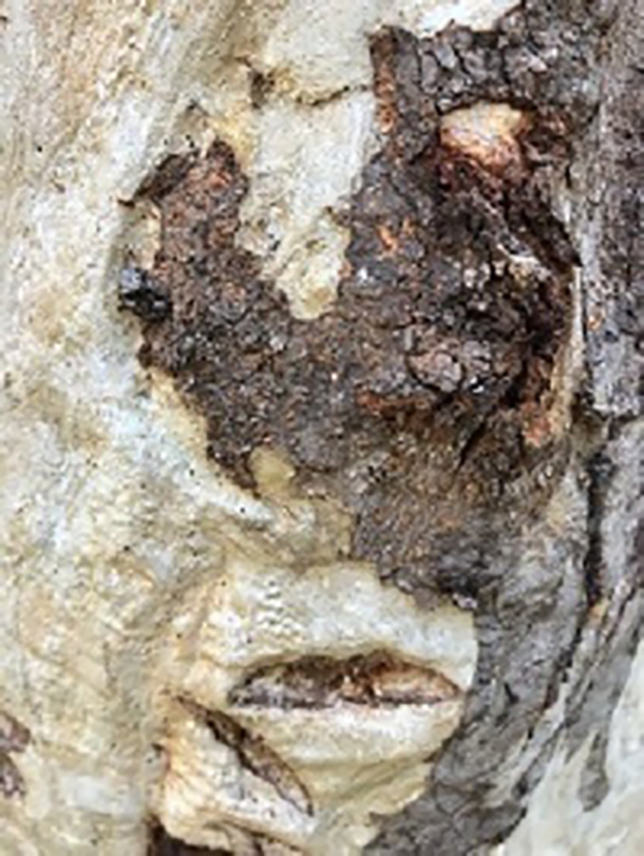
I was drawn to an old, very high, monumental pine tree, Pinus radiata, in our front yard. It took me about a year to climb when I was twelve or thirteen. At first I was stuck on the ground, too small to reach the lowest limbs. I studied the trunk closely. As I grew taller and stronger, I managed to find footholds and began to climb. Then I would reach a branch and could not go on, halted by fear, descending with mixed feelings of disappointment and pride. After a few days, or weeks or months, I would return again and again and sure enough each time discover I could go higher. Eventually I made it all the way up to the crown. I could see all the way down Beleura Hill Road into town, feeling the wind as never before. I went up there often, nestled for hours, hidden away, fulfilled and euphoric, sucking in the sweet pine scent, watching the rooftops and cars below, like Italo Calvino’s Baron in the Trees (1977) although I was not overly privileged, nor fleeing parental discipline. I was, simply, entirely free for a while and exultant. I began to need this emotion. In my later teen years I found myself going away, into nature, to experience place — I now realise — as John Urry describes, in a ‘solitudinous, personal, semi-spiritual relationship’, leading to ever new quests for ‘emotional and solitary appropriation’ of landscapes of ‘beauty ... and desire’ (Urry 2005: 78).
In those days I never considered what I was doing in terms of Romanticism or any other ism. My immersion in nature was not yet an antidote to the hollow, conflicted realm of politics and celebrity, the daily bread of the newspaperman. All I knew about nature was visceral, not intellectual. I felt wonderful, somehow more complete, calmer and stronger, in nature. The wildest, hardest to access surf spots, an abandoned, collapsing farmhouse invaded by scrub: these became my haunts, alone or with one or two friends. I had no desire to experience nature acquisitively. I was not interested in seeking possible utopias. I did not spread the news about any of the places I found, nor did I seek to keep them secret. I only wanted nature to remain nature because what I craved was the feelings nature evoked. Mick Smith explains how nature is capable of meaningful, emotional expression:
Springs [or rivers, waves, beaches, birds, trees] ... do in some sense speak to me, they affect me, move me, altering my understanding of my relations to my surrounding environment. Their activities make me attend to the modes in which they present and express themselves and, just as with other humans, they thereby acquire meaning and value, they become significant. (Smith 2005: 222)
Smith undermines anthropocentric prejudices, arguing that expression, interpretation and affection do not occur exclusively between humans. Like Smith, I have grown interested in an ‘affective natural historicity, of the ways the Earth comes to be inscribed in our hearts’ (2005: 223).
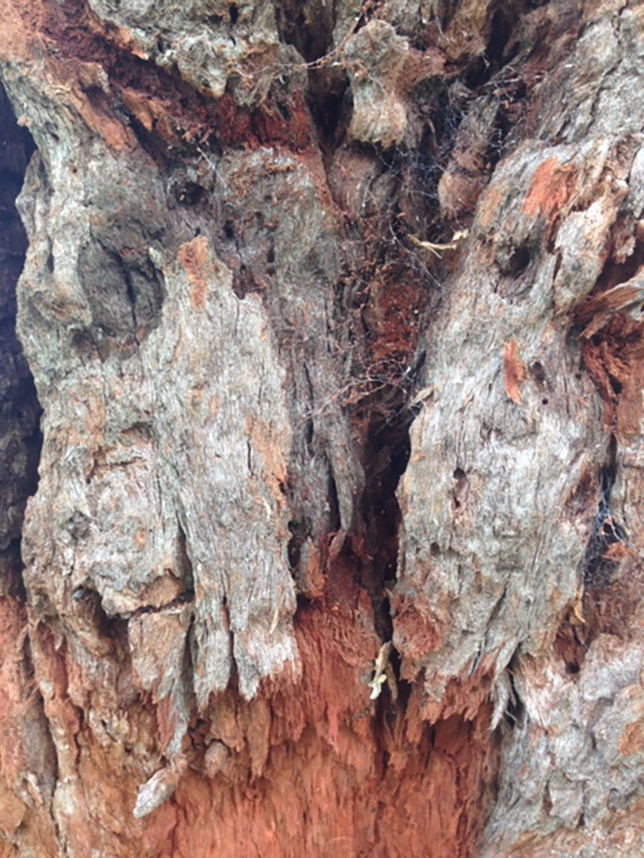
A few years ago, I began to recognise faces in trees. This recognition occurred while I was researching property development pressures on the last remaining undeveloped foreshore on the Gold Coast, a narrow strip of sand and littoral forest separating the Broadwater estuary from the ocean, known as The Spit. In the Gold Coast City Council bush parks where I walked our dog (not on The Spit), and near the base of Mt Ainslie in Canberra during a trip to visit our son, I photographed outlines and shapes of faces in markings on the bark and in the callouses of tree trunks. The faces were normatively incomplete or abstract, but they were vivid. So far, I have stored sixteen tree faces in my phone. As I composed the first few photos, frozen in front of a tree pointing my phone, Holly barked, staring at the tree and then at me. I had no idea if she recognised the tree looking back at us, if she wanted me to keep on walking, or if something else was happening.
Four hundred years ago, Michel de Montaigne wondered about humans and animals:
How does he know, by the force of his intelligence, the secret internal stirrings of animals? By what comparison between them and us does he infer the stupidity that he attributes to them? When I play with my cat, who knows if I am not a pastime to her more than she is to me? (Montaigne 1957: 331)
Few of the millions of people watching cat videos on YouTube know about Montaigne’s cat. Montaigne observed that his cat chose when to take part in and when to finish games. The cat was deciding how the play would go, not Montaigne. As Jacques Derrida explains, Montaigne is arguing for the capacity of animals to respond while contemplating the ‘naïve assurance’ of the human who presumes to decide the extent of that capacity (Derrida 2002: 375). This is the kind of naïve assurance of one who assumes he or she is better, that they know best. We remain at the mercy of naïve assurances, which may be calculating but are still naïve. Donald Trump will make America great again. A highrise casino and cruise ship terminal will guarantee the economic future of the Gold Coast.
Property development on the Spit would ignore the cultural as well as the ecological value of trees. If Montaigne’s cat and my dog had more to say than we might generally imagine, why not trees? Peter Wohlleben in The Hidden Life of Trees (2016), Sophie Cunningham in City of Trees (2019) and David George Haskell in The Songs of Trees (2020) discuss how trees communicate biologically with each other and are engaged in the anthropocene. I wondered how my empathetic recognition of faces in trees might be understood as a biocentric ontology in which such recognition acknowledges communication by trees in another sense.
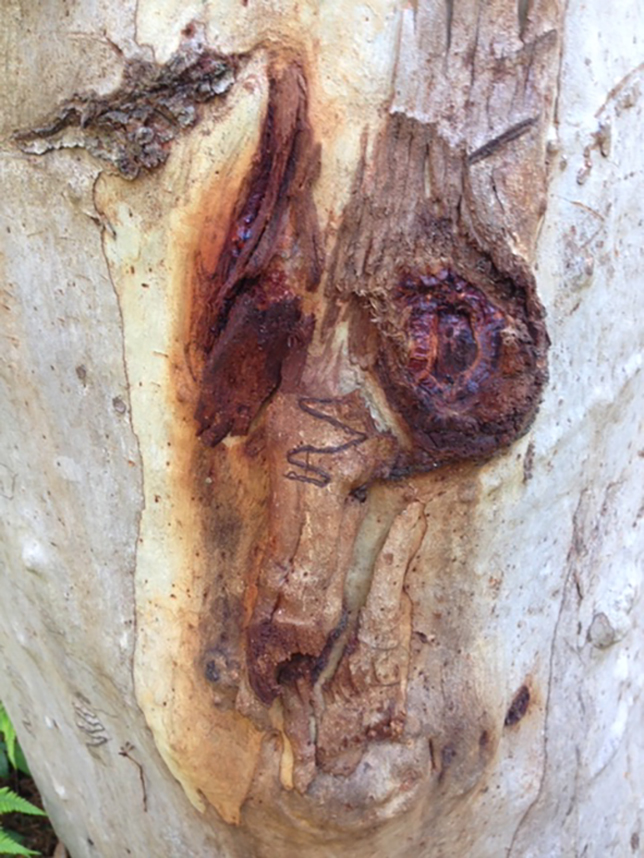
These were not the first trees I had recognised with humanoid shapes. The celebrated sculptures and carvings of Indigenous figures by William Ricketts, in situ in the Dandenong Ranges in Victoria (see Rolls 2018), appeared to me as clumsy desecrations representing a colonial appropriation of Indigeneity. I had seen countless Pinterest displays of humanoid trees, by and large digital fakes or amateurish montages with manufactured materials. I was intrigued by the so-called Malaysian ghost tree, a face on the trunk of a betel nut palm in the village of Kampung Paya, attracting thousands of visitors in 2006. Photographs of the Malaysian ghost tree were offered for sale, like postcards (Huggler 2006). And I had interviewed Richard St Barbe Baker, the reforestation activist, who looked like a tree, dressed in shades of green, jumper, cardigan, jacket, hat, slacks wrapping around him like layers of bark, tall and thin and stiff with old age.
Pareidolia, the perception of an object as stimulus for a visual pattern known to the observer, is exemplified by popular conceptions of the man in the moon or the face on Mars, or other recognisable images in clouds, rocks or mountains. Pareidolia was once considered a partial hallucination, a form of psychosis, but has been acknowledged as a normal human tendency, able to be replicated by computers (Rosen 2012). We are hardwired to recognise faces. Faces trigger and assist our earliest forms of emotional understanding. Recognising faces in nature is not a specific purpose application, not a Rorschach process determining a state of mind, beyond confirming our sensitivities to nature. Nor are faces in trees as I see them anything like religious apparitions, the face of Jesus in Vegemite spread on toast or in decomposing paint stains on the walls of Italian villages or on the Shroud of Turin. I am looking for faces in trees and they are a revelation but as far as I know I am not investing religious significance. Some of the faces in the trees in my photographs convey emotional expression, a gravity of seriousness, a mask of captive restraint, wry acidic hallucination, whimsical sadness, faint melancholy. They are a generally sombre dramatis personae. If they are masks, they are not a disguise.
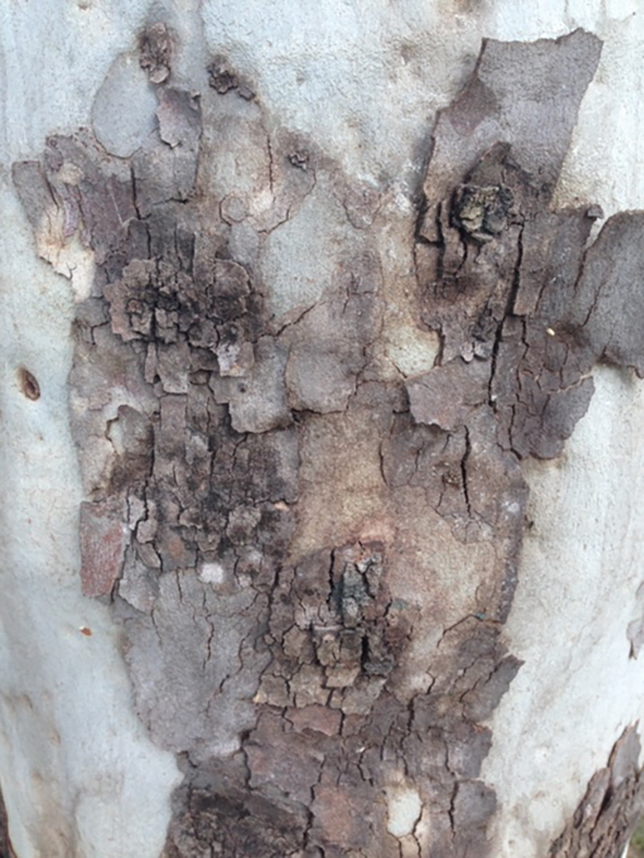
My research led me to Germaine Greer’s Cave Creek narrative, White Beech (2015), in which she recalls how the enthralling antics of a regent bowerbird with ‘dazzling’ feathers ‘persuaded’ her to buy a remote sanctuary high up in the Gold Coast hinterland, surrounded by national parks at the headwaters of the Nerang River (2015: 93—95; 301—309). Greer’s rainforest in parts is so steep and thickly forested it is almost impenetrable by humans. There is no doubt that she attends to the modes in which birds express themselves and that such expression has for her significant meaning and value.
Investigating the history of her forest, Greer realised that two young men mythologised as the founders of the Gold Coast (see McRobbie 1982: 14) made a monumental discovery in the Cave Creek district. The timber cutters Edmund Harper and William Duncan trekked north in 1846 from camps along the Tweed caldera into steep country not yet explored by whites. They ‘made their way through the Numinbah Gap ... to the point where Cave Creek enters the Nerang River ... [and] stumbled upon the biggest Red Cedar they had ever seen’ (Greer 2015: 167—68). The tree was too big and too remote for Harper and Duncan to dispatch. They hurried back south to the Tweed. Before long, timber cutters were swarming over the Numinbah Valley, home to some of the last cedar stands to be felled on the Australian east coast. Harper built a wharf on the river at what is now Surfers Paradise. Duncan had a sawmill next to the wharf. The Numinbah cedars were floated or towed down the river to the wharf, loaded on to ships and taken via the Broadwater to Brisbane. It is possible to argue that the Gold Coast was established not by people, but trees. The living cedar is gone from Australia; just a few, odd invisible loners survive in inaccessible country. Cedar still has value as a processed artefact, near the top of the commercial hierarchy of wood. Some of Australia’s finest antique furniture is made from cedar.
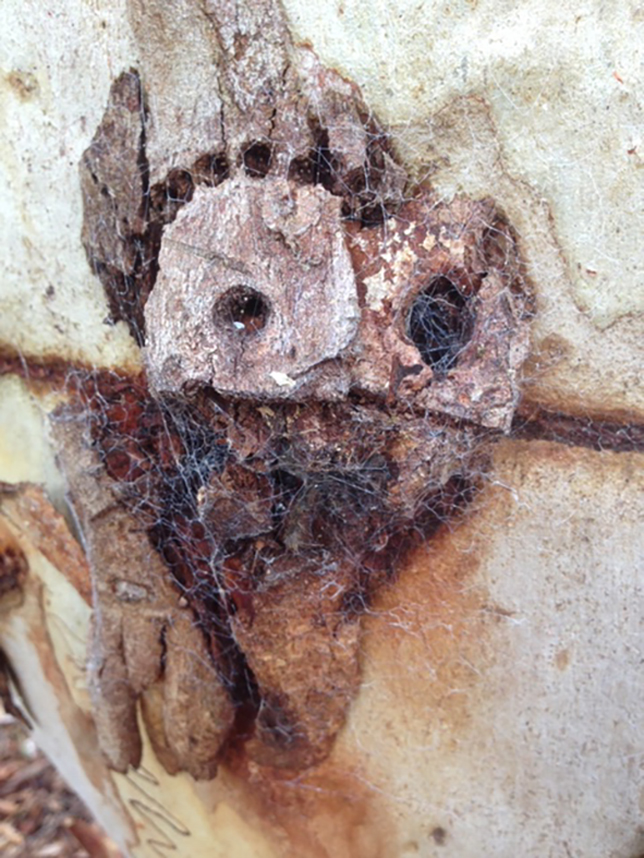
We look at trees differently from the ways they might look at us. Maybe there is overlap. Trees are objects of an acquisitive gaze that desires mountain and forest views. At the same time, they are removed if they obstruct views, especially ocean views, or stand in the way of property development. Without wood, we may struggle to be comfortable emotionally and physically. Trees help keep us alive by oxygenating the air we breathe. They coexist in the biocentric and anthropocentric realms. They engage intimately with the four classical elements: their nourishment is the air, earth and water and they are regenerated by fire. They signify life — the tree of life, the family tree, the Christmas tree, the tree of knowledge, the money tree. The burnt tree, the decomposed tree is the divine building block element. Annie Dillard notes the molecular structures of chlorophyll and haemoglobin are similar (1974: 126—27), so trees and humans share a related life force, a similar mosaic. More than 150 years after hundreds if not thousands of trees were extracted from the Gold Coast hinterland, the place where the Nerang River ends at the sea is the location for one of Queensland’s most enduring tree planting efforts, among the long groves of hardy casuarinas at The Spit. In this sense, The Spit is a space of resurrection, enabling nature in a small but significant way to recover what has been lost.
Attending a Friends of Federation Walk volunteers’ tree planting day on The Spit in June 2016, I was intrigued by the large grove of casuarinas linking the Main Beach oceanside public park to The Spit, winding around the Marina Mirage luxury resort, as if the casuarinas were guides or totems whose ubiquitous presence connects The Spit to the rest of the Gold Coast. Matthew Condon’s reminiscence of The Spit (2003) and Thomas Shapcott’s tree poem (1989) each evoke casuarinas as sirens of their landscape. Trees of course appear frequently in poetry. Larkin, Plath, Frost, Manley Hopkins, Joyce Kilmer, Clive James: all have memorialised the songs of trees. In fiction, Richard Powers’ The Overstory (2018) situates photographs of trees at the core of an epic family tale. I knew that casuarinas have a rare ability to extract nitrogen from the atmosphere and store it in their root nodules. When a casuarina tree dies at The Spit, the nitrogen fixed in its roots is released into the sand, providing a key nutrient. So casuarinas have a nurturing identity, as well as their evocative, expressive power.
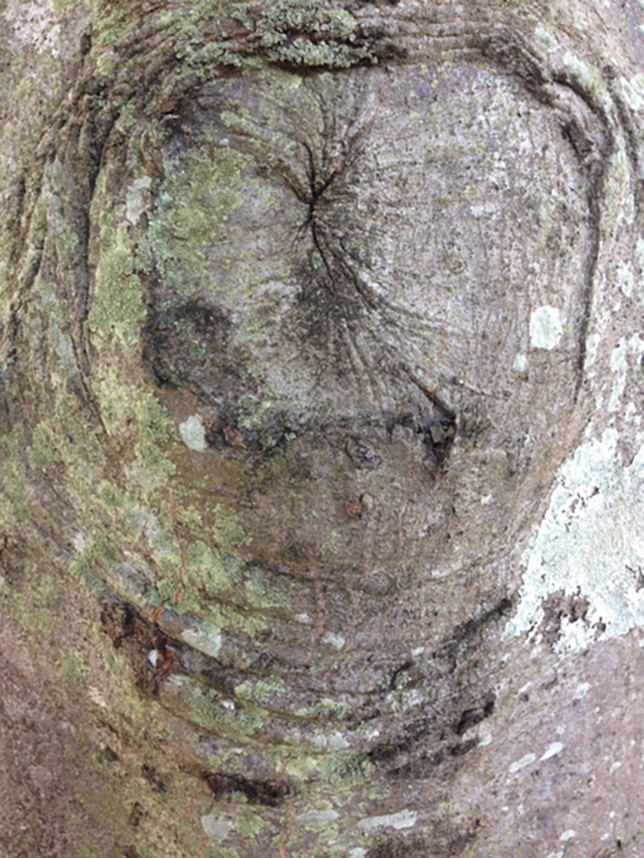
Dillard is inspired by moments when we are nothing but a feeling part of nature, so enthralled by a profound vision that we lose consciousness of everything else, escaped from the ‘ceaseless flow of trivia and trash’ (Dillard 1974: 32). Dillard is ‘knocked breathless’ when, like a blind person who suddenly sees, she recognises a cedar tree in the backyard of her Virginian forest cabin glowing with light, ‘charged and transfigured, each cell buzzing with flame’, not on fire but bright as fire (1974: 33). Later she decides that regardless of what caused this vision, she had seen an ‘undeniably new spirit’ (1974: 241), even if there may be a rational explanation. She suspects the tree with lights was the shining of ‘purulent’ or suppurating galls (1974: 242). Galls are abnormal growths, bulbous or in clusters, on tree trunks or in foliage, formed by parasitic insects or fungi triggering cells to enlarge or multiply, becoming food for their creators. Dillard perceives the glowing tree as simultaneously otherworldly and of this world, in this case elusively beautiful as well as ugly. If nature can evoke a higher consciousness, it is also an actual realisation.
On the Burleigh headland walking track, on the central Gold Coast, I stopped to talk with an old woman standing at the highest coastal lookout. We spoke about Jabreen’s Fingers. I asked her if she knew how to find them. She told me, pointing over the cliff, ‘go off the track, right here’. I wriggled under the safety fence and on to the very edge of the cliff where a small sandy path, invisible from the lookout, led into the trees. I looked back. The old woman was gone, as if she had never been there. I went carefully along the path and came upon a giant Moreton Bay fig. I crawled under the vast canopy, inside a natural chamber. The bright sky sparkled above the thick cover of leaves. My roof was a brilliant silver, white, blue and green kaleidoscope. I had arrived at a Dillardian place of wonder. I scrambled down a little further and sat next to Jabreen’s Fingers, staring out at the surf, following Jabreen’s gaze, high up on the cliff face. Jabreen’s Fingers are horizontal, heptagonal basalt columns, signifying the Kombumerri myth of Jabreen, a creation figure. The basalt columns are also understood as remnants from the eruption of the Tweed volcano 23 million years ago. A few months after my visit, Jabreen’s Fingers were desecrated by Instagram girls, covering the largest of the fingers, a smooth rock platform thrusting out like a diving board towards the ocean, with pastel chalk markings, love hearts and other social media hieroglyphs.
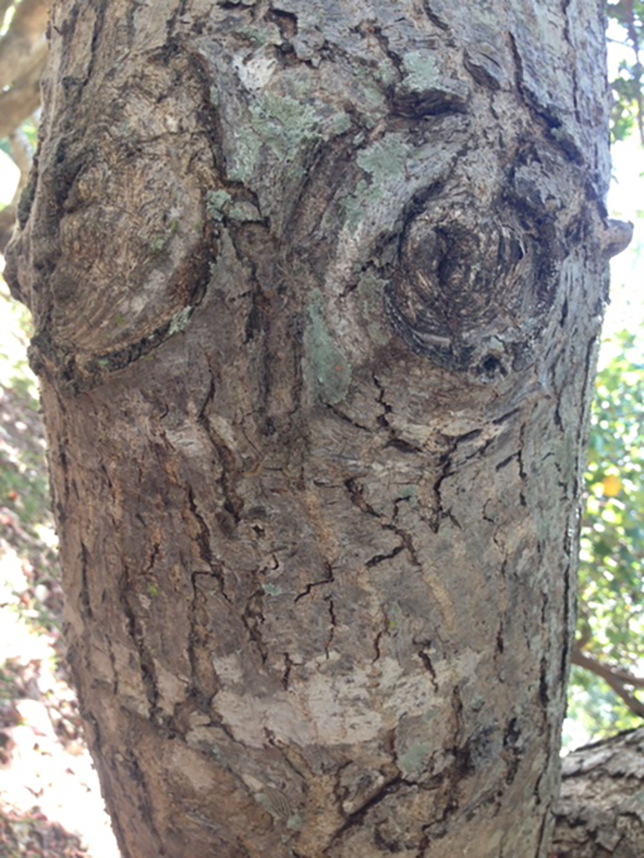
According to Gary Snyder, the idea of ‘good land’ derives from agriculture opposed to whatever is wild (Snyder 1990: 78—79). I interviewed Snyder during his 1981 Australian tour, when he visited activists battling to save the Terania Creek rainforest in northern New South Wales from logging. Snyder on this visit also met with Indigenous leaders in central Australia, and gave readings in Canberra at the Australian National University. Our conversation at the Montsalvat artists’ colony at Eltham in Victoria was a challenging intellectual journey. Snyder wove a complex tapestry of ideas about the inter-relationships of humans, animals, mountains, deserts, rivers, trees and much of the rest of nature, themes he has explored in his poetry, interviews and speeches since the 1960s. Good land implies soil productive for cropping and grazing (1990: 78—79). Wild creatures threaten good, cultivated land. Cultivated implies civilised. But wild land is not unproductive: its plants and animals sustain each other, they are never ‘out of place’ (1990: 79). Animals like cattle and pigs made un-wild are ‘sluggish meat making machines’ (1990: 79). Hunters and gatherers, human and non-human, range far wider on wild land than farmers on good land, yet hunters and gatherers also have a systematic land management approach. The difference between hunter gatherer societies like the Kombumerri before the 1850s and the white settlers who came later to the Gold Coast is that good land became private property. Appreciating these distinctions exposes the hypocrisy of the development group who would carve up The Spit for profit. On the one hand, they argue The Spit is not good land, little more than an overgrown rubbish tip, or ‘all trees and unusable’ (Newlands 2016: 13). On the other, they claim The Spit is valuable real estate. The idea of good land has evolved on the Gold Coast to mean land good for building on, while the pro-development narrative of the no-good Spit sprinkled with straggly casuarina forest is a cynical propagandising tactic.
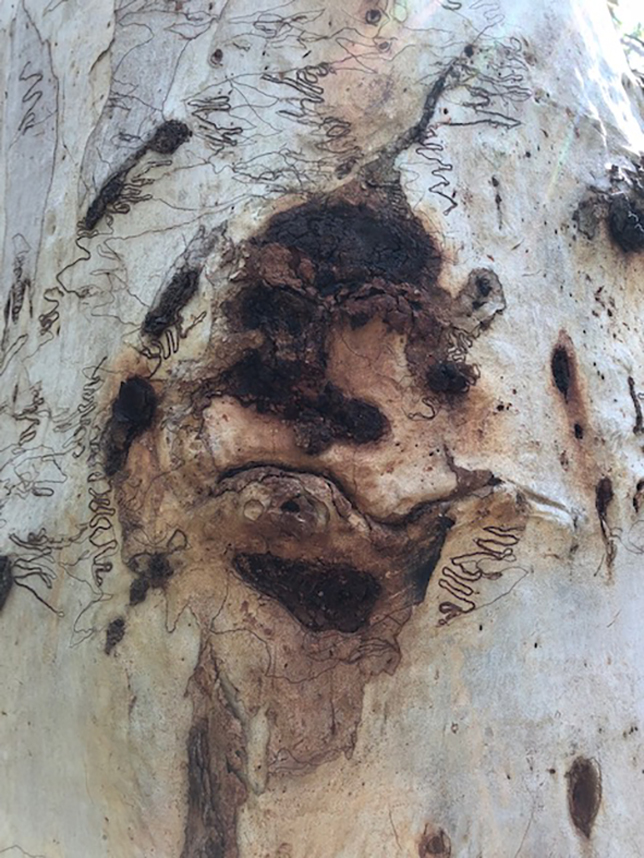
In the early twentieth century, Max Weber identified disenchantment as an injury of modernity, in which wonder, being comfortable to some degree with not knowing, is replaced by will, the need for mastery, because everything is mastered by calculation, the star of modernity (see Macfarlane 2016: 24—25). Forty years later, Martin Heidegger extrapolated Weber’s disenchantment, which is really a lament for nature. Heidegger decided for better or worse that technology has made the world a standing reserve of energy, available for use any way we like, resulting in an ‘inadequate and unsatisfying’ relationship with nature (see Macfarlane 1990: 25). And so, as Robert Macfarlane explains, we ‘have become experts in analysing what nature can do for us, but lack a language to evoke what it can do to us’ (Macfarlane 1990: 25). Because technology, now a function of neoliberalism and globalisation, usurps the quality of wonder, we are faced with the difficulty of reconciling nature as something it is fundamentally not. We are struck by a kind of existential panic. We either rush to embrace nature, recognising its nourishing beauty is to be valued or fearing it will be lost or that we owe it a debt of protection, or we hasten to exploit it, better that we make it ours and it help make us rich, rather than linger over what might have been or what might be, because if we don’t act quickly nature will be taken from us, by greenies or governments or someone else. The would-be exploiters of nature are the kinds of people who are driven to make naïve assurances. They do not want to linger in nature, as they feel that is a sign of weakness, a lack of mastery.
As I explored my feelings about faces in trees, I realised it might be possible to consider these faces as an ecosemiotic language of trees, although I am not interested as much in conceptual theory as in a particular quality of wonder, a resurrection of nature, that might infuse visual and textual poetics of the faces. As well, I am conscious of what my recognition of faces in trees reveals about myself. I am allocating another identity for trees. Is this denying the essence of trees, a quasi-colonial construct? At the same time, I am attracted to the idea that trees are not anonymous, that I am able to consider an individual tree in the same way I might approach a friend or a stranger. It is not that I discovered faces in trees. They had in a way shown themselves to me. I feel better able to appreciate the connectedness of trees with the soil, the sky and each other. And to imagine how I might feel like a tree. The interplay between trees and humans.
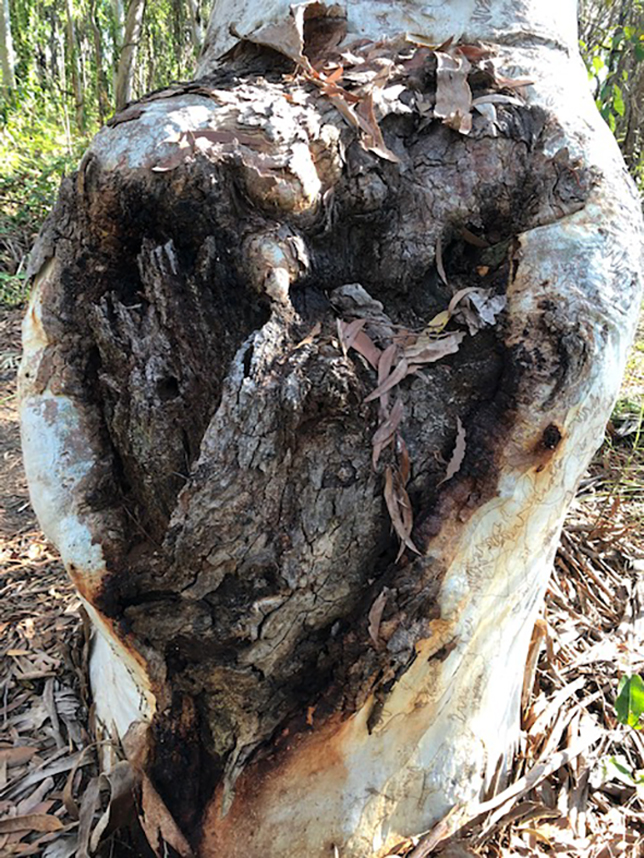
Calvino, I 1977 The Baron in the Trees, New York, NY: Mariner
Condon, M 2003—2004 ‘The casuarina forest’, Griffith Review: Dreams of Land (Summer): 39—49
Cunningham S 2019 City of Trees, Melbourne: Text
Derrida, J 2002 ‘The animal that therefore I am (more to follow)’, Critical Inquiry 28.2: 369—418
Dillard, A 1974 Pilgrim at Tinker Creek, New York, NY: Harper & Row
Greer, G 2015 White Beech, The Rainforest Years, London: Bloomsbury
Haskell, DG 2020 The Songs of Trees, Carlton: Black Inc
Huggler, J 2006 ‘Malaysians flock to ghostly apparition in betel nut tree’, New Zealand Herald (14 September), https://www.nzherald.co.nz/world/malaysians-flock-to-ghostly-apparition-in-betel-nut-tree/DI7P34BTADWZE2DF4EJKWMMCMM/ (accessed 14 April 2020)
Macfarlane, R 2016 Landmarks, North Sydney: Penguin Australia
McRobbie, A 1982 The Surfers Paradise Story, Surfers Paradise: Pan News
Montaigne, M de 1957 The Complete Works of Montaigne (trans DM Frame), Palo Alto, CA: Stanford University Press
Newlands, J 2016 ‘Thinktank’ column, Gold Coast Bulletin (31 October), p.13
Powers, Richard 2018 The Overstory, London: Vintage
Rolls, M 2018 ‘Friday essay: William Ricketts Sanctuary is a racist anachronism’, The Conversation (25 May), https://theconversation.com/friday-essay-william-ricketts-sanctuary-is-a-racist-anachronism-but-can-it-foster-empathy-96274 (accessed 14 April 2020)
Rosen, R 2012 ‘Pareidolia: A bizarre bug of the human mind emerges in computers’, The Atlantic (7 August), https://www.theatlantic.com/technology/archive/2012/08/pareidolia-a-bizarre-bug-of-the-human-mind-emerges-in-computers/260760/ (accessed 14 April 2020)
Shapcott, T 1989 ‘Myth of the casuarina’, Selected Poems 1956—1988, St Lucia: University of Queensland Press, 239—40
Smith, M 2005 ‘On “being” moved by nature: Geography, emotion and environmental ethics’, in J Davidson, L Bondi, M Smith (eds), Emotional Geographies, London & New York: Routledge, 219—30
Snyder, G 1990 The Practice of the Wild, New York, NY: Farrar, Straus and Giroux
Urry, J 2005 ‘The place of emotions within place’, in J Davidson, L Bondi and M Smith (eds), Emotional Geographies, London & New York: Routledge, 77—83
Wohlleben, P 2016 The Hidden Life of Trees, Carlton: Black Inc